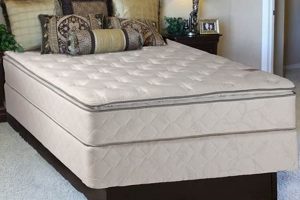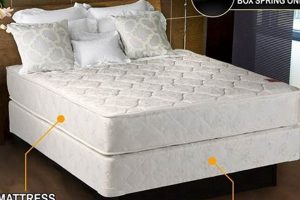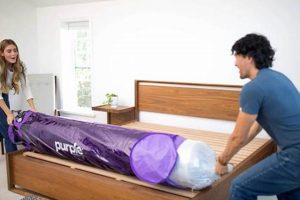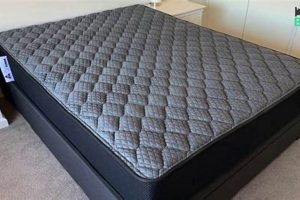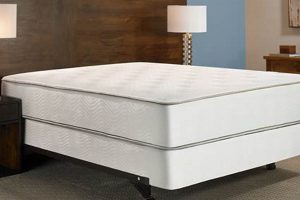The necessity of a box spring when using a memory foam mattress is a common inquiry. A box spring traditionally provides support and elevation for innerspring mattresses. However, memory foam mattresses, known for their conforming properties, often have different support requirements.
Proper support is crucial for the longevity and performance of a memory foam mattress. Adequate support prevents sagging, ensures even weight distribution, and contributes to a comfortable sleep experience. Historically, box springs were the standard for all mattress types, but contemporary mattress designs and foundation options offer alternatives that may be more suitable for memory foam.
The following sections will explore various foundation options for memory foam mattresses, examine the factors to consider when choosing a support system, and discuss the potential benefits and drawbacks of using a box spring versus alternative foundations.
Guidance on Memory Foam Mattress Support Systems
Selecting the appropriate support system for a memory foam mattress significantly impacts its lifespan and the sleeper’s comfort. Careful consideration of various factors is essential to make an informed decision.
Tip 1: Review Manufacturer Recommendations: Always consult the memory foam mattress manufacturer’s guidelines. These recommendations often specify approved foundation types that maintain warranty validity and optimize mattress performance.
Tip 2: Assess Foundation Firmness: Memory foam mattresses generally benefit from a firm, even surface. A foundation with inadequate support can cause premature sagging and diminish the mattress’s conforming properties.
Tip 3: Consider Platform Beds: Platform beds, with their solid or closely spaced slats, provide a stable and supportive base. Ensure the slats are no more than a few inches apart to prevent uneven wear.
Tip 4: Evaluate Adjustable Bases: Adjustable bases offer customizable support and positioning. Compatibility with a memory foam mattress depends on the base’s design and the mattress’s flexibility.
Tip 5: Inspect Existing Box Springs: If considering the use of an existing box spring, thoroughly inspect its condition. Sagging, broken coils, or an uneven surface render it unsuitable for supporting a memory foam mattress.
Tip 6: Determine Desired Bed Height: Account for the mattress and foundation height to achieve the preferred bed height. Accessibility and aesthetics are key considerations.
Tip 7: Factor in Weight Capacity: Ensure the chosen foundation can adequately support the combined weight of the mattress and occupants. Exceeding the weight limit can compromise the foundation’s structural integrity.
Adhering to these guidelines helps ensure the memory foam mattress receives the necessary support for optimal comfort, longevity, and warranty compliance.
The subsequent sections will delve into the long-term implications of foundation choice and explore common issues related to memory foam mattress support.
1. Support Requirements
The query regarding the necessity of a box spring with a memory foam mattress hinges directly on the mattress’s specific support requirements. Unlike traditional innerspring mattresses designed to work in tandem with a box spring, memory foam mattresses often perform optimally on different foundation types. The primary function of a support system is to prevent sagging, maintain structural integrity, and ensure proper spinal alignment during sleep. For instance, if a memory foam mattress lacks adequate support, it can develop indentations over time, diminishing comfort and potentially leading to musculoskeletal issues for the user. The manufacturer’s specifications usually detail the recommended support system for each mattress model; adhering to these guidelines is crucial for maximizing the lifespan and performance of the memory foam mattress.
Failure to meet the support requirements of a memory foam mattress can have tangible consequences. Consider a scenario where a new memory foam mattress is placed on an old, sagging box spring. The uneven surface of the box spring will create localized stress points on the mattress, accelerating wear and tear. This can manifest as visible indentations, reduced responsiveness of the memory foam, and a general decline in sleep quality. In contrast, a solid platform bed or a slatted foundation with closely spaced slats provides a stable, uniform surface, effectively distributing weight and minimizing the risk of sagging. Furthermore, using an unapproved support system may void the mattress warranty, leaving the consumer responsible for any resulting damage or defects.
In summary, understanding and adhering to the support requirements of a memory foam mattress is paramount. The need for a box spring is not a given; rather, it depends on the specific mattress model and the condition of the existing box spring, if one is being considered. Prioritizing a foundation that provides firm, even support is essential for preserving the mattress’s integrity, ensuring optimal comfort, and protecting the consumer’s investment. Alternative support systems, such as platform beds or adjustable bases, often provide superior performance and are frequently recommended by manufacturers.
2. Warranty Compliance
Warranty compliance is inextricably linked to the question of whether a box spring is necessary for a memory foam mattress. Mattress manufacturers establish specific requirements for foundation types to ensure proper support and weight distribution. Non-compliance with these stipulations can invalidate the warranty, rendering the consumer responsible for any defects or damage that may arise. For instance, a manufacturer might explicitly state that a memory foam mattress must be used on a solid platform bed or a slatted foundation with slats spaced no more than a certain distance apart. Placing the mattress on an unsupported or unsuitable box spring, such as one with sagging coils or uneven surfaces, could be deemed a violation of the warranty terms. This can create a significant financial risk for the consumer if the mattress develops indentations or other structural issues within the warranty period.
Consider a scenario where a consumer purchases a high-end memory foam mattress and places it on an existing box spring that is several years old. Unbeknownst to the consumer, the box spring’s internal structure is compromised, leading to uneven support. Within a year, the memory foam mattress develops a noticeable sag in the area where the box spring is weakest. When the consumer attempts to claim warranty coverage, the manufacturer’s inspection reveals the use of an unsuitable foundation, resulting in the denial of the claim. This example underscores the critical importance of carefully reviewing the manufacturer’s warranty requirements and ensuring that the chosen foundation complies with those specifications. Failure to do so can result in the loss of warranty protection and the associated financial burden of replacing a defective mattress.
In summary, warranty compliance represents a pivotal aspect of mattress ownership, particularly for memory foam models. Understanding and adhering to the manufacturer’s foundation requirements is essential to safeguard the warranty and protect against potential defects. Consumers should carefully review the warranty documentation, consult with the retailer or manufacturer if clarification is needed, and select a foundation that meets the specified criteria. Neglecting this aspect can have significant financial ramifications, leaving the consumer without recourse in the event of mattress failure. Therefore, the decision of whether to use a box spring with a memory foam mattress should be guided, in part, by the need to maintain warranty compliance.
3. Foundation Alternatives
The inquiry into the necessity of a box spring with a memory foam mattress is directly addressed through an exploration of foundation alternatives. The conventional pairing of box springs with innerspring mattresses does not automatically translate to memory foam applications. Foundation alternatives represent a range of support systems designed to meet the unique requirements of memory foam mattresses. These alternatives include platform beds, slatted foundations, adjustable bases, and even the option of placing the mattress directly on the floor. The selection of an appropriate foundation alternative significantly influences the mattress’s longevity, support, and overall comfort. The consideration of foundation alternatives is crucial for optimizing the performance of memory foam mattresses and for adhering to manufacturer warranty stipulations.
Platform beds, for example, provide a solid and even surface, effectively preventing sagging and ensuring uniform weight distribution. Slatted foundations, when constructed with closely spaced slats, offer a similar level of support while promoting air circulation. Adjustable bases offer a distinct advantage by allowing users to customize the mattress’s position, catering to individual comfort preferences or medical needs. In contrast, a deteriorated or incompatible box spring can compromise the integrity of a memory foam mattress, leading to premature wear and reduced comfort. The decision to forgo a box spring in favor of an alternative often reflects a deliberate choice to enhance support and prolong the mattress’s lifespan. Manufacturer guidelines frequently recommend specific foundation types that are best suited for their memory foam products, emphasizing the importance of considering alternatives to the traditional box spring.
In summary, foundation alternatives constitute a critical component in determining the suitability of a box spring for a memory foam mattress. These alternatives offer diverse support options designed to address the specific needs of memory foam materials. Selecting the appropriate foundation alternative not only maximizes comfort and extends the mattress’s lifespan but also ensures compliance with warranty requirements. The understanding and consideration of these alternatives are essential for informed decision-making regarding memory foam mattress support.
4. Platform Bed Suitability
Platform bed suitability directly influences the determination of box spring necessity with a memory foam mattress. The design of platform beds, characterized by a solid or slatted surface, provides inherent support that often negates the need for a box spring. If a platform bed offers a sufficiently firm and even surface, a box spring becomes redundant and potentially detrimental. Introducing an additional layer of cushioning via a box spring can compromise the intended support and contouring characteristics of the memory foam. For example, placing a memory foam mattress on a platform bed with closely spaced slats ensures uniform weight distribution, minimizing the risk of sagging and maximizing the mattress’s lifespan. This configuration contrasts with the potential instability of a box spring that may have uneven coils or a compromised structure.
The evaluation of platform bed suitability requires careful consideration of slat spacing and material strength. Excessive gaps between slats can lead to uneven support and localized compression of the memory foam, diminishing its performance and potentially voiding the manufacturer’s warranty. Conversely, a platform bed with a solid surface or closely spaced, robust slats provides an optimal foundation for memory foam, allowing it to conform to the sleeper’s body while maintaining its structural integrity. Practical application involves assessing the platform bed’s construction, verifying its ability to support the combined weight of the mattress and occupants, and confirming adherence to the mattress manufacturer’s recommendations. Furthermore, platform beds often offer aesthetic advantages, contributing to a streamlined and modern bedroom design.
In summary, platform bed suitability is a crucial factor in deciding whether a box spring is required for a memory foam mattress. When a platform bed provides adequate support through its solid or appropriately slatted design, a box spring becomes unnecessary. Challenges arise primarily from ensuring the platform bed’s construction meets the specific support requirements of the memory foam mattress, as outlined by the manufacturer. Understanding this connection is essential for optimizing sleep comfort, prolonging the mattress’s lifespan, and maintaining warranty compliance, all of which contribute to the broader theme of informed mattress selection and foundation compatibility.
5. Adjustable Base Options
Adjustable base options directly influence the necessity of a box spring with a memory foam mattress. Adjustable bases, designed to articulate and elevate portions of the mattress, inherently negate the need for a traditional box spring. The structure of an adjustable base provides a supportive framework, rendering the supplemental support of a box spring redundant and potentially detrimental to the adjustable base’s functionality. Implementing a box spring between an adjustable base and a memory foam mattress can impede the articulation of the base, hindering its intended range of motion and potentially damaging the mechanical components. For example, an individual seeking relief from back pain or acid reflux may choose an adjustable base to elevate the head and torso; the inclusion of a box spring would compromise this functionality.
Practical applications of adjustable bases with memory foam mattresses necessitate a direct interface between the mattress and the adjustable frame. Many adjustable bases feature retainer bars or non-slip surfaces to prevent the mattress from shifting during articulation. These features are designed to function optimally without the intermediary of a box spring. Compatibility between the adjustable base and the memory foam mattress is paramount; manufacturers often specify weight limits and mattress thickness guidelines to ensure proper operation. Integrating a box spring not only interferes with the adjustable base’s functionality but can also introduce instability and reduce the lifespan of both the base and the mattress. Adjustable bases offer targeted support and customized positioning that are not achievable with traditional box spring configurations.
In summary, the adoption of adjustable base options renders the use of a box spring with a memory foam mattress unnecessary and, in most instances, counterproductive. Adjustable bases are engineered to provide direct support and articulation, making a box spring redundant. Understanding this connection is essential for maximizing the benefits of an adjustable base, ensuring proper mattress support, and preventing damage to the base’s mechanical components. Consumers should consult manufacturer guidelines to confirm compatibility between the chosen memory foam mattress and the adjustable base, prioritizing a direct interface for optimal performance.
6. Bed Height Preferences
Bed height preferences are directly linked to the consideration of whether a box spring is required with a memory foam mattress. The desired height of the sleeping surface significantly influences the choice of foundation and the potential inclusion of a box spring. Individuals may prefer a higher or lower bed for reasons of accessibility, aesthetics, or personal comfort. The decision to utilize a box spring often stems from the need to achieve a specific bed height that aligns with these preferences. For instance, a person with mobility limitations may require a higher bed for easier ingress and egress. In such cases, a box spring, in conjunction with a memory foam mattress, could provide the necessary elevation. Conversely, individuals favoring a minimalist aesthetic may opt for a lower profile bed, negating the need for a box spring and instead choosing a platform bed or a low-profile foundation.
The practical implication of bed height preferences manifests in the selection of appropriate foundation alternatives. If a platform bed is chosen to support a memory foam mattress, the resulting bed height will depend on the platform bed’s design. A low-profile platform bed will yield a lower sleeping surface, while a raised platform bed will provide greater elevation. Similarly, the use of an adjustable base also influences the overall bed height. Adjustable bases often have a considerable height, which may preclude the need for a box spring to achieve the desired bed height. Careful measurement and consideration of existing furniture, such as nightstands, are essential when determining the optimal bed height. An inappropriately high or low bed can compromise comfort and accessibility, underscoring the importance of aligning foundation choices with individual preferences.
In summary, bed height preferences are a critical consideration when evaluating the necessity of a box spring with a memory foam mattress. The desired height dictates the selection of appropriate foundation alternatives, including platform beds, adjustable bases, and the option of using a box spring. Accurately assessing bed height preferences ensures optimal comfort, accessibility, and aesthetic harmony within the bedroom environment. Challenges primarily arise from balancing desired height with mattress support requirements and foundation compatibility. The informed consideration of bed height preferences contributes to the broader theme of personalized sleep solutions tailored to individual needs.
7. Mattress Longevity
Mattress longevity is intrinsically linked to the decision of whether a box spring is required for a memory foam mattress. The type of support system employed directly impacts the lifespan of a memory foam mattress. An inadequate or incompatible foundation can lead to premature wear, sagging, and a reduction in the mattress’s overall lifespan. For example, a memory foam mattress placed on an old, sagging box spring will experience uneven weight distribution, causing localized stress points and accelerating the breakdown of the foam. In contrast, a properly chosen foundation, such as a platform bed or a slatted foundation with appropriate spacing, provides uniform support, minimizing stress and extending the mattress’s useful life. The lifespan of a memory foam mattress represents a significant investment, and selecting the correct support system is paramount to protecting that investment.
The impact of foundation choice on mattress longevity can be quantified. A memory foam mattress placed on an unsupported surface may exhibit a significant decrease in lifespan compared to the manufacturer’s expectations. For instance, indentations and sagging can develop within a few years, necessitating premature replacement. Conversely, a mattress supported by a suitable foundation can maintain its integrity and comfort for the duration of its warranty period and beyond. Practical considerations include assessing the condition of an existing box spring and determining whether it meets the specific support requirements of the memory foam mattress. Manufacturer guidelines often stipulate the acceptable foundation types, and adherence to these guidelines is crucial for preserving the mattress’s longevity and warranty coverage. Foundation alternatives, such as adjustable bases, further complicate this decision by offering both support and functionality, requiring careful evaluation of their compatibility with the memory foam mattress.
In summary, mattress longevity is a key consideration when addressing the question of whether a box spring is needed for a memory foam mattress. The support system chosen directly influences the mattress’s lifespan, and selecting an appropriate foundation is essential for protecting the investment and ensuring long-term comfort. Challenges arise in determining the suitability of existing box springs and in navigating the array of foundation alternatives. Ultimately, informed decision-making, guided by manufacturer recommendations and a thorough understanding of support requirements, is crucial for maximizing mattress longevity.
Frequently Asked Questions Regarding Memory Foam Mattress and Box Spring Usage
The following addresses common inquiries concerning the necessity of a box spring with a memory foam mattress, providing concise and informative answers.
Question 1: Is a box spring universally required for memory foam mattresses?
No, a box spring is not universally required. The necessity depends on the specific support needs of the mattress and the existing bed frame. Platform beds or slatted foundations may provide adequate support without a box spring.
Question 2: What are the potential consequences of using an unsuitable foundation with a memory foam mattress?
An unsuitable foundation can lead to premature sagging, reduced comfort, and potential voiding of the mattress warranty. Uneven weight distribution can compromise the mattress’s structural integrity.
Question 3: How does a platform bed compare to a box spring in terms of support for memory foam mattresses?
A platform bed, with its solid or closely spaced slats, generally provides more uniform and stable support compared to a traditional box spring. This can be particularly beneficial for memory foam mattresses.
Question 4: Can an adjustable base be used with a memory foam mattress, and does it require a box spring?
Yes, adjustable bases are compatible with many memory foam mattresses. A box spring is not required, as the adjustable base itself provides the necessary support and articulation.
Question 5: How does bed height factor into the decision of whether to use a box spring?
Bed height preferences can influence the choice of foundation. If a higher bed is desired, a box spring may be used in conjunction with a platform bed or other foundation to achieve the desired height.
Question 6: What should be considered when evaluating an existing box spring for use with a memory foam mattress?
The condition of the existing box spring must be assessed. Sagging, broken coils, or uneven surfaces render it unsuitable for supporting a memory foam mattress. Its dimensions should also match the mattress.
In summary, the decision regarding box spring usage with a memory foam mattress should be based on the specific mattress requirements, the existing bed frame, and individual preferences for support and height. Consulting the manufacturer’s recommendations is advisable.
The subsequent section will address practical considerations for selecting a suitable foundation.
Do I Need Box Spring with Memory Foam Mattress
The preceding exploration illuminates the nuanced relationship between memory foam mattresses and box springs. The necessity of a box spring is not inherent but contingent upon factors including mattress construction, existing bed frame support, desired bed height, and adherence to manufacturer warranty stipulations. Foundation alternatives such as platform beds and adjustable bases often provide superior support and functionality compared to traditional box springs, negating the need for their inclusion. Careful assessment of these elements is paramount to optimize sleep comfort, ensure mattress longevity, and maintain warranty compliance.
The informed selection of a mattress support system constitutes a critical investment in sleep quality and long-term well-being. It is incumbent upon consumers to prioritize thorough research, consult manufacturer guidelines, and critically evaluate available foundation options to determine the optimal configuration. The pursuit of restorative sleep demands a deliberate and discerning approach to mattress and foundation compatibility.


![Complete Twin Beds: Mattress & Box Spring Set [Deals] Organic & Natural Mattress Buyer’s Guide: Non-Toxic Sleep Solutions Complete Twin Beds: Mattress & Box Spring Set [Deals] | Organic & Natural Mattress Buyer’s Guide: Non-Toxic Sleep Solutions](https://mattressworldpa.com/wp-content/uploads/2025/07/th-3405-300x200.jpg)
